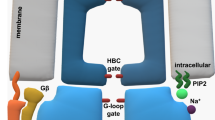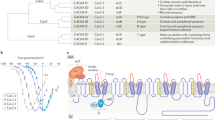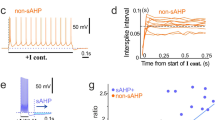Abstract
It was recently discovered that two different types of voltage-insensitive K+ channels, G protein-coupled inwardly rectifying K+ (GIRK) and small-conductance Ca2+-activated K+ (SK) channels, are located on dendritic branches, spines and shafts in the postsynaptic densities of excitatory synapses in many central neurons. Together with increases in our knowledge of how these channels are regulated through stable protein–protein interactions in multi-protein complexes, this has added another layer of complexity to our understanding of synaptic transmission and plasticity.
This is a preview of subscription content, access via your institution
Access options
Subscribe to this journal
Receive 12 print issues and online access
$189.00 per year
only $15.75 per issue
Buy this article
- Purchase on Springer Link
- Instant access to full article PDF
Prices may be subject to local taxes which are calculated during checkout



Similar content being viewed by others
References
Gutman, G. A. et al. International Union of Pharmacology. LIII. Nomenclature and molecular relationships of voltage-gated potassium channels. Pharmacol. Rev. 57, 473–508 (2005).
Kubo, Y. et al. International Union of Pharmacology. LIV. Nomenclature and molecular relationships of inwardly rectifying potassium channels. Pharmacol. Rev. 57, 509–526 (2005).
Wei, A. D. et al. International Union of Pharmacology. LII. Nomenclature and molecular relationships of calcium-activated potassium channels. Pharmacol. Rev. 57, 463–472 (2005).
Inanobe, A. et al. Characterization of G-protein-gated K+ channels composed of Kir3.2 subunits in dopaminergic neurons of the substantia nigra. J. Neurosci. 19, 1006–1017 (1999).
Iwanir, S. & Reuveny, E. Adrenaline-induced hyperpolarization of mouse pancreatic islet cells is mediated by G protein-gated inwardly rectifying potassium (GIRK) channels. Pflugers Arch. 456, 1097–1108 (2008).
Strassmaier, T. et al. A novel isoform of SK2 assembles with other SK subunits in mouse brain. J. Biol. Chem. 280, 21231–21236 (2005).
Dascal, N. Signalling via the G protein-activated K+ channels. Cell. Signal. 9, 551–573 (1997).
Peleg, S., Varon, D., Ivanina, T., Dessauer, C. W. & Dascal, N. Gαi controls the gating of the G protein-activated K+ channel, GIRK. Neuron 33, 87–99 (2002).
Clancy, S. M. et al. Pertussis-toxin-sensitive Gα subunits selectively bind to C-terminal domain of neuronal GIRK channels: evidence for a heterotrimeric G-protein-channel complex. Mol. Cell. Neurosci. 28, 375–389 (2005).
Fowler, C. E., Aryal, P., Suen, K. F. & Slesinger, P. A. Evidence for association of GABAB receptors with Kir3 channels and regulators of G protein signalling (RGS4) proteins. J. Physiol. 580, 51–65 (2007).
Doupnik, C. A. GPCR-Kir channel signaling complexes: defining rules of engagement. J. Recept. Signal Transduct. Res. 28, 83–91 (2008).
Hill, J. J. & Peralta, E. G. Inhibition of a Gi-activated potassium channel (GIRK1/4) by the Gq-coupled m1 muscarinic acetylcholine receptor. J. Biol. Chem. 276, 5505–5510 (2001).
Xia, X.-M. et al. Mechanism of calcium gating in small-conductance calcium-activated potassium channels. Nature 395, 503–507 (1998).
Nikolov, E. N. & Ivanova-Nikolova, T. T. Coordination of membrane excitability through a GIRK1 signaling complex in the atria. J. Biol. Chem. 279, 23630–23636 (2004).
Medina, I. et al. A switch mechanism for Gβγ activation of IKACh . J. Biol. Chem. 275, 29709–29716 (2000).
Rusinova, R. et al. Mass spectrometric analysis reveals a functionally important PKA phosphorylation site in a Kir3 channel subunit. Pflugers Arch. 458, 303–314 (2009).
Mao, J. et al. Molecular basis for the inhibition of G protein-coupled inward rectifier K+ channels by protein kinase C. Proc. Natl Acad. Sci. USA 101, 1087–1092 (2004).
Keselman, I., Fribourg, M., Felsenfeld, D. P. & Logothetis, D. E. Mechanism of PLC-mediated Kir3 current inhibition. Channels (Austin) 1, 113–123 (2007).
Thomas, A. M., Brown, S. G., Leaney, J. L. & Tinker, A. Differential phosphoinositide binding to components of the G protein-gated K+ channel. J. Membr. Biol. 211, 43–53 (2006).
Brown, S. G., Thomas, A., Dekker, L. V., Tinker, A. & Leaney, J. L. PKCδ sensitizes Kir3.1/3.2 channels to changes in membrane phospholipid levels after M3 receptor activation in HEK-293 cells. Am. J. Physiol. Cell Physiol. 289, C543–C556 (2005).
Bildl, W. et al. Protein kinase CK2 is coassembled with small conductance Ca2+-activated K+ channels and regulates channel gating. Neuron 43, 847–858 (2004).
Allen, D., Fakler, B., Maylie, J. & Adelman, J. P. Organization and regulation of small conductance Ca2+-activated K+ channel multiprotein complexes. J. Neurosci. 27, 2369–2376 (2007).
Willars, G. B. Mammalian RGS proteins: multifunctional regulators of cellular signalling. Semin. Cell Dev. Biol. 17, 363–376 (2006).
Doupnik, C. A., Davidson, N., Lester, H. A. & Kofuji, P. RGS proteins reconstitute the rapid gating kinetics of Gβγ-activated inwardly rectifying K+ channels. Proc. Natl Acad. Sci. USA 94, 10461–10466 (1997).
Jaen, C. & Doupnik, C. A. RGS3 and RGS4 differentially associate with G protein-coupled receptor-Kir3 channel signaling complexes revealing two modes of RGS modulation. Precoupling and collision coupling. J. Biol. Chem. 281, 34549–34560 (2006).
David, M. et al. Interactions between GABA-B1 receptors and Kir 3 inwardly rectifying potassium channels. Cell. Signal. 18, 2172–2181 (2006).
Luscher, C., Jan, L. Y., Stoffel, M., Malenka, R. C. & Nicoll, R. A. G protein-coupled inwardly rectifying K+ channels (GIRKs) mediate postsynaptic but not presynaptic transmitter actions in hippocampal neurons. Neuron 19, 687–695 (1997).
Labouebe, G. et al. RGS2 modulates coupling between GABAB receptors and GIRK channels in dopamine neurons of the ventral tegmental area. Nature Neurosci. 10, 1559–1568 (2007).
Lomazzi, M., Slesinger, P. A. & Luscher, C. Addictive drugs modulate GIRK-channel signaling by regulating RGS proteins. Trends Pharmacol. Sci. 29, 544–549 (2008).
Ma, D. et al. Diverse trafficking patterns due to multiple traffic motifs in G protein-activated inwardly rectifying potassium channels from brain and heart. Neuron 33, 715–729 (2002).
Lunn, M. L. et al. A unique sorting nexin regulates trafficking of potassium channels via a PDZ domain interaction. Nature Neurosci. 10, 1249–1259 (2007).
Lin, M. T., Lujan, R., Watanabe, M., Adelman, J. P. & Maylie, J. SK2 channel plasticity contributes to LTP at Schaffer collateral-CA1 synapses. Nature Neurosci. 11, 170–177 (2008).
Karschin, C., Dissmann, E., Stuhmer, W. & Karschin, A. IRK(1–3) and GIRK(1–4) inwardly rectifying K+ channel mRNAs are differentially expressed in the adult rat brain. J. Neurosci. 16, 3559–3570 (1996).
Wickman, K., Karschin, C., Karschin, A., Picciotto, M. R. & Clapham, D. E. Brain localization and behavioral impact of the G-protein-gated K+ channel subunit GIRK4. J. Neurosci. 20, 5608–5615 (2000).
Signorini, S., Liao, Y. J., Duncan, S. A., Jan, L. Y. & Stoffel, M. Normal cerebellar development but susceptibility to seizures in mice lacking G protein-coupled, inwardly rectifying K+ channel GIRK2. Proc. Natl Acad. Sci. USA 94, 923–927 (1997).
Koyrakh, L. et al. Molecular and cellular diversity of neuronal G-protein-gated potassium channels. J. Neurosci. 25, 11468–11478 (2005).
Marker, C. L., Lujan, R., Colon, J. & Wickman, K. Distinct populations of spinal cord lamina II interneurons expressing G-protein-gated potassium channels. J. Neurosci. 26, 12251–12259 (2006).
Marker, C. L., Lujan, R., Loh, H. H. & Wickman, K. Spinal G-protein-gated potassium channels contribute in a dose-dependent manner to the analgesic effect of μ- and δ- but not κ-opioids. J. Neurosci. 25, 3551–3559 (2005).
Aguado, C. et al. Cell type-specific subunit composition of G protein-gated potassium channels in the cerebellum. J. Neurochem. 105, 497–511 (2008).
Cruz, H. G. et al. Bi-directional effects of GABAB receptor agonists on the mesolimbic dopamine system. Nature Neurosci. 7, 153–159 (2004).
Stocker, M. & Pedarzani, P. Differential distribution of three Ca2+-activated K+ channel subunits, SK1, SK2, and SK3, in the adult rat central nervous system. Mol. Cell. Neurosci. 15, 476–493 (2000).
Sailer, C. A., Kaufmann, W. A., Marksteiner, J. & Knaus, H. G. Comparative immunohistochemical distribution of three small-conductance Ca2+-activated potassium channel subunits, SK1, SK2, and SK3 in mouse brain. Mol. Cell. Neurosci. 26, 458–469 (2004).
Drake, C. T., Bausch, S. B., Milner, T. A. & Chavkin, C. GIRK1 immunoreactivity is present predominantly in dendrites, dendritic spines, and somata in the CA1 region of the hippocampus. Proc. Natl Acad. Sci. USA 94, 1007–1012 (1997).
Chen, X. & Johnston, D. Constitutively active G-protein-gated inwardly rectifying K+ channels in dendrites of hippocampal CA1 pyramidal neurons. J. Neurosci. 25, 3787–3792 (2005).
Kulik, A. et al. Compartment-dependent colocalization of Kir3.2-containing K+ channels and GABAB receptors in hippocampal pyramidal cells. J. Neurosci. 26, 4289–4297 (2006).
Masugi-Tokita, M. & Shigemoto, R. High-resolution quantitative visualization of glutamate and GABA receptors at central synapses. Curr. Opin. Neurobiol. 17, 387–393 (2007).
Ladera, C. et al. Pre-synaptic GABA receptors inhibit glutamate release through GIRK channels in rat cerebral cortex. J. Neurochem. 107, 1506–1517 (2008).
Fernández-Alacid, L. Subcellular compartment-specific molecular diversity of pre- and postsynaptic GABAB-activated GIRK channels in Purkinje cells. J. Neurochem. (in the press).
Scanziani, M. GABA spillover activates postsynaptic GABAB receptors to control rhythmic hippocampal activity. Neuron 25, 673–681 (2000).
Huang, C. S. et al. Common molecular pathways mediate long-term potentiation of synaptic excitation and slow synaptic inhibition. Cell 123, 105–118 (2005).
Chung, H. J., Qian, X., Ehlers, M., Jan, Y. N. & Jan, L. Y. Neuronal activity regulates phosphorylation-dependent surface delivery of G protein-activated inwardly rectifying potassium channels. Proc. Natl Acad. Sci. USA 106, 629–634 (2009).
Chung, H. J. et al. G protein-activated inwardly rectifying potassium channels mediate depotentiation of long-term potentiation. Proc. Natl Acad. Sci. USA 106, 635–640 (2009).
Ngo-Anh, T. J. et al. SK channels and NMDA receptors form a Ca2+-mediated feedback loop in dendritic spines. Nature Neurosci. 8, 642–649 (2005).
Bloodgood, B. L. & Sabatini, B. L. Nonlinear regulation of unitary synaptic signals by CaV2.3 voltage-sensitive calcium channels located in dendritic spines. Neuron 53, 249–260 (2007).
Faber, E. S., Delaney, A. J. & Sah, P. SK channels regulate excitatory synaptic transmission and plasticity in the lateral amygdala. Nature Neurosci. 8, 635–641 (2005).
Stackman, R. W. et al. Small conductance Ca2+-activated K+ channels modulate synaptic plasticity and memory encoding. J. Neurosci. 22, 10163–10171 (2002).
Hammond, R. S. et al. Small-conductance Ca2+-activated K+ channel type 2 (SK2) modulates hippocampal learning, memory, and synaptic plasticity. J. Neurosci. 26, 1844–1853 (2006).
Faber, E. S. et al. Modulation of SK channel trafficking by beta adrenoceptors enhances excitatory synaptic transmission and plasticity in the amygdala. J. Neurosci. 28, 10803–10813 (2008).
Acknowledgements
We thank M. Lin for valuable discussions and comments on the manuscript. R.L. is supported by the Spanish Ministry of Education and Science (BFU-2006-01896/BFI and CONSOLIDER CSD2008-00005) and Junta de Comunidades de Castilla-La Mancha (PAI08-0174-6,967). Grants from the US National Institutes of Health support J.M. (MH081860) and J.P.A. (MH076752 and NS038880).
Author information
Authors and Affiliations
Corresponding author
Supplementary information
Supplementary information S1 (box)
Localization of and putative roles for presynaptic GIRK channels in GABAB–mediated regulation of glutamate release. (PDF 220 kb)
Related links
Rights and permissions
About this article
Cite this article
Luján, R., Maylie, J. & Adelman, J. New sites of action for GIRK and SK channels. Nat Rev Neurosci 10, 475–480 (2009). https://doi.org/10.1038/nrn2668
Issue Date:
DOI: https://doi.org/10.1038/nrn2668
This article is cited by
-
Exploring the Therapeutic Effect of Neurotrophins and Neuropeptides in Neurodegenerative Diseases: at a Glance
Molecular Neurobiology (2023)
-
Antidepressant activity of pharmacological and genetic deactivation of the small-conductance calcium-activated potassium channel subtype-3
Psychopharmacology (2022)
-
Bee venom acupuncture therapy ameliorates neuroinflammatory alterations in a pilocarpine-induced epilepticus model
Metabolic Brain Disease (2021)
-
Emerging roles for G protein-gated inwardly rectifying potassium (GIRK) channels in health and disease
Nature Reviews Neuroscience (2010)



